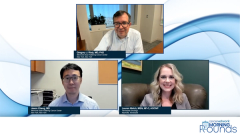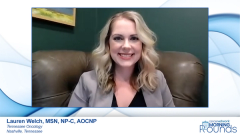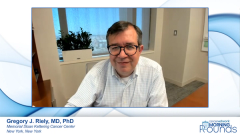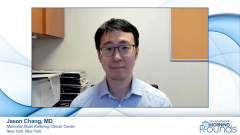
Improving Outcomes in Non-Small Cell Lung Cancer: Future Directions in Care
Best treatment approaches for patients with advanced NSCLC in the context of individualized therapy and an evolving therapeutic landscape.
Episodes in this series

Transcript:
Gregory J. Riely, MD, PhD: If you have a patient like this—we talked about other patients who live a long way away, and it’s hard for them to come in—how do you think that through, Lauren? How does that play into treatment decisions? How you want to approach the patient?
Lauren Welch, MSN, NP-C, AOCNP: Are we talking about a patient who has an EGFR mutation or any patient?
Gregory J. Riely, MD, PhD: Let’s broaden it to any patient, or if you have a patient with EGFR and you’re thinking about second- or third-line therapies. How do you think through some of the agents we have to offer?
Lauren Welch, MSN, NP-C, AOCNP: We’re always considering the logistical and the travel burden on the patient: what support do they have, are they still trying to work, who’s going to bring them to the clinic? At the beginning of any therapy, though, we want to keep close eyes on them. If they start an oral targeted therapy, we want to see them back in the clinic within a couple of weeks to see them in person, check their labs, talk to them about how they’re doing. For patients who are good advocates, and you can tell that they understand what you’re recommending. We’ll sometimes do telemedicine with those patients, and maybe do local labs to ease the travel burden on those folks. When we’re selecting chemotherapy regimens, some are obviously more demanding and involved than others. Once you get through your first 4 cycles of platinum I/O [immuno-oncology], can you transition to cue 6-week pembrolizumab? Things like that that help the patient live as normal a life as possible, where they’re not always stuck in your infusion room.
Gregory J. Riely, MD, PhD: That’s a key thing to think about. When we’re trying to help patients in this initial time, when they’ve recently been diagnosed, it’s hard to think about the big role this cancer is going to play in their day-to-day life going forward. When we end up making second- and third-line treatment decisions, it’s often easier because the patient has learned to accommodate life with cancer and is more in charge of focusing on their health rather than the other obligations in life. It’s certainly a challenge.
I take that into my mind when I think about some of the approaches people have used in, say, EGFR-mutant lung cancer. We’re trying to explore ways to improve outcomes for these patients. One of the big trials we’re waiting on results for is the trial that combines osimertinib with chemotherapy. If that trial is positive, for this group of patients we currently write a prescription for a pill, check their toxicities in a couple weeks, and see them every few months, we could convert them into somebody who’s getting IV [intravenous] chemotherapy every 3 weeks. It’s a change in the way we think. As we interpret the data from those trials, we must put it in the context of how much it’s going to affect patients’ lives to go back from a pill a day to a pill a day plus lots of visits to the infusion suite. It definitely plays into our thinking.
This has been a wonderful conversation. Thank you for joining us in this lively discussion on non–small cell lung cancer brought to you by Cancer Network®. We hope you found this interactive discussion to be informative and beneficial to your clinical practice.
Transcript edited for clarity.
Newsletter
Stay up to date on recent advances in the multidisciplinary approach to cancer.



















































































